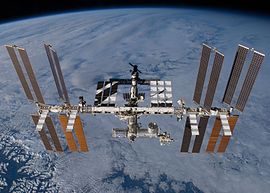- Mir-2
-
Mir-2 was a space station project begun in February 1976.[1] Some of the modules built for Mir-2 have been incorporated into the International Space Station (ISS). The project underwent many changes, but was always based on the DOS-8 base block space station core module, built as a back-up to the DOS-7 base block used in the Mir station. The DOS-8 base block was eventually used as the Zvezda module of the ISS. Its design lineage extends back to the original Salyut stations.[2][3][4]
Contents
Project history
The evolution of the Mir-2 project
1981 to 1987: KB Salyut Mir-2
The prototype of the central module was as Polyus. Mir-2 would be capable of docking at least four modules in ordinary operation.
December 14, 1987: NPO Energia Mir-2
Designated as OSETS (Orbital Assembly and Operations Centre). The station would be built in a 65 degree orbit and consist of 90 ton modules.
- Launch 1 - DOS 8,providing housing for the assembly crew.
- Launch 2 - 90 ton module.
- Launch 3 - Truss and solar arrays.
- Launches 4 to 6 - additional 90 ton modules.
1991: "Mir-1.5"
This would involve launch of the DOS-8, after which the Buran shuttle would grapple the module, rendezvous with Mir, and attach it to the old DOS-7 base block. This plan was later altered so that DOS-8 would maneuver and dock itself to Mir. It would remain attached for two years.
1992: "Mir-2"
The station would consist of the DOS-8 core module and a cross beam called the NEP (Science Power Platform). This was equipped with MSB retractable solar panels, Sfora thruster packages and small scientific packages.
Four 3 to 4 ton modules were planned:
- Docking Module - with the APDS universal androgynous docking system, and a side hatch for space walks
- Resource Module - Equipped with gyrodynes for orienting the station and a passive docking port for docking of Soyuz or Progress ferry spacecraft
- Technology Module - with materials experiments
- Biotechnology Module
November 1993: International Space Station built around Mir-2
 The International Space Station in November 2009.
The International Space Station in November 2009.
Russian elements of the International Space Station include:
- Zarya FGB, the first element launched. This was a US-funded TKS-derived propulsion module built by KB Salyut.
- Zvezda Service Module - this is the DOS-8 station, which was launched as the third major ISS module in July 2000.
- SO-1 (Pirs) - one of the docking modules originally designed for Buran/Mir-2 was added to the station in September 2001.
- SO-2 Poisk - A module similar to Pirs. Poisk also provides extra space for scientific experiments, and power-supply outlets and data-transmission interfaces for external scientific payloads.
References
- ^ "Mir-2" (in english) (HTML). Astronautix. http://www.astronautix.com/craft/mir2.htm. Retrieved 12 February 2011.
- ^ Anatoly Zak. "International Space Station - MIR-2: Russian roots of the ISS program (1969-1992)" (in english) (HTML). Russian Space Web. http://www.russianspaceweb.com/iss.html. Retrieved 12 February 2011.
- ^ "ISS Elements: Service Module ("Zvezda")" (in english) (HTML). SpaceRef.com. http://www.spaceref.com/iss/elements/sm.html. Retrieved 12 February 2011.
- ^ Henry Spencer (2 November 2010). "High life: a short history of the space station" (in english) (HTML). New Scientist. http://www.newscientist.com/article/dn19668-high-life-a-short-history-of-the-space-station.html. Retrieved 12 February 2011.
External links
Preceded by
MirMir-2 project design
14 December 1987 - November 1993Succeeded by
Russian Orbital SegmentSpace stations and habitats Active Defunct Soviet Union
and RussiaUnited StatesCancelled ISS-incorporated Developmental ChinaSpace Complex Alpha · Space Complex BravoRussiaOPSEK · LOSProposed Rotating wheel · Bernal sphere · O'Neill cylinder · Stanford torus · Wet workshop · Space habitat · Industrial Space Facility · Orbital Technologies Commercial Space Station1 Never inhabited 2 Failed launch 3 Part of the Almaz military programSoviet and Russian government manned space programs Active Past Cancelled Categories:- Space stations
- Soviet Union spacecraft stubs
Wikimedia Foundation. 2010.
